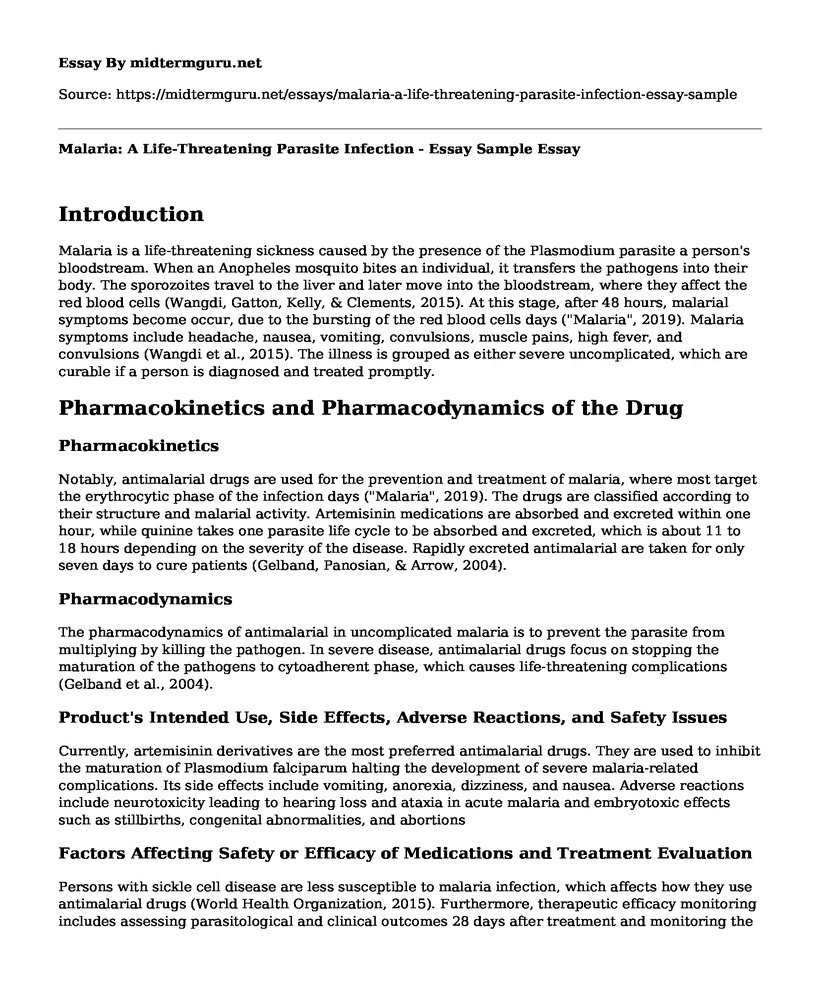Introduction
Malaria is a life-threatening sickness caused by the presence of the Plasmodium parasite a person's bloodstream. When an Anopheles mosquito bites an individual, it transfers the pathogens into their body. The sporozoites travel to the liver and later move into the bloodstream, where they affect the red blood cells (Wangdi, Gatton, Kelly, & Clements, 2015). At this stage, after 48 hours, malarial symptoms become occur, due to the bursting of the red blood cells days ("Malaria", 2019). Malaria symptoms include headache, nausea, vomiting, convulsions, muscle pains, high fever, and convulsions (Wangdi et al., 2015). The illness is grouped as either severe uncomplicated, which are curable if a person is diagnosed and treated promptly.
Pharmacokinetics and Pharmacodynamics of the Drug
Pharmacokinetics
Notably, antimalarial drugs are used for the prevention and treatment of malaria, where most target the erythrocytic phase of the infection days ("Malaria", 2019). The drugs are classified according to their structure and malarial activity. Artemisinin medications are absorbed and excreted within one hour, while quinine takes one parasite life cycle to be absorbed and excreted, which is about 11 to 18 hours depending on the severity of the disease. Rapidly excreted antimalarial are taken for only seven days to cure patients (Gelband, Panosian, & Arrow, 2004).
Pharmacodynamics
The pharmacodynamics of antimalarial in uncomplicated malaria is to prevent the parasite from multiplying by killing the pathogen. In severe disease, antimalarial drugs focus on stopping the maturation of the pathogens to cytoadherent phase, which causes life-threatening complications (Gelband et al., 2004).
Product's Intended Use, Side Effects, Adverse Reactions, and Safety Issues
Currently, artemisinin derivatives are the most preferred antimalarial drugs. They are used to inhibit the maturation of Plasmodium falciparum halting the development of severe malaria-related complications. Its side effects include vomiting, anorexia, dizziness, and nausea. Adverse reactions include neurotoxicity leading to hearing loss and ataxia in acute malaria and embryotoxic effects such as stillbirths, congenital abnormalities, and abortions
Factors Affecting Safety or Efficacy of Medications and Treatment Evaluation
Persons with sickle cell disease are less susceptible to malaria infection, which affects how they use antimalarial drugs (World Health Organization, 2015). Furthermore, therapeutic efficacy monitoring includes assessing parasitological and clinical outcomes 28 days after treatment and monitoring the reoccurrence of pathogens in the bloodstream.
References
Gelband, H., Panosian, C. B., & Arrow, K. J. (Eds.). (2004). Saving lives, buying time: economics of malaria drugs in an age of resistance. Washington, DC: National Academies Press.
Malaria. (2019). Center for Disease Control. Retrieved from https://www.cdc.gov/malaria/about/disease.html
Wangdi, K., Gatton, M. L., Kelly, G. C., & Clements, A. C. (2015). Cross-border malaria: a major obstacle for malaria elimination. In Advances in Parasitology, 89, pp. 79-107. https://doi.org/10.1016/bs.apar.2015.04.002
World Health Organization. (2015). Guidelines for the treatment of malaria. World Health Organization. Retrieved from https://www.ncbi.nlm.nih.gov/books/NBK294423/
Cite this page
Malaria: A Life-Threatening Parasite Infection - Essay Sample. (2023, Jan 23). Retrieved from https://midtermguru.com/essays/malaria-a-life-threatening-parasite-infection-essay-sample
If you are the original author of this essay and no longer wish to have it published on the midtermguru.com website, please click below to request its removal:
- Implications of Nursing Theory in Validating Research Knowledge Towards Evidence-Based Practice
- Essay on Exploring Health Literacy in the Rural South
- Paper Example on Social and Psychological Implications of STD's
- Sexting, Texting, Cyberbullying and Keeping Youth Safe Online - Article Analysis Essay
- Tobacco Smoke Exposure: An Unprecedented Health and Economic Burden - Essay Sample
- Essay Sample on Elderly Abuse Mandatory Reporting
- Pernicious Anemia: Causes, Symptoms, & Treatments - Research Paper







